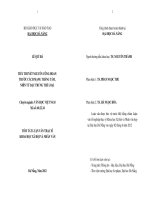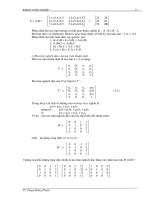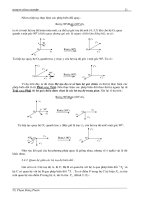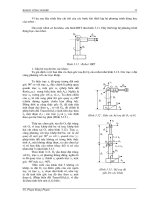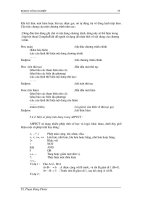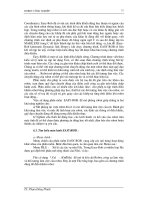trung nguyên
Bạn đang xem bản rút gọn của tài liệu. Xem và tải ngay bản đầy đủ của tài liệu tại đây (1001.08 KB, 37 trang )
THE MINISTRY OF FINANCE
ACADEMY OF FINANCE
------ oOo ------
MARKETING FACULTY
Topic : MARKETING STRATEGY OF TRUNG NGUYEN COFFEE
Lớp: CQ56.11.03.CLC
Thành viên:
1.
Lại Hương Liên
2.
Đào Ngọc Anh
3.
Lê Thu Uyên
4.
Nguyễn Thị Khánh Linh
5.
Trần Quỳnh Anh
6.
Nguyễn Thị Trang
Hà Nội, ngày 22 tháng 11 năm 2020
A, Company Overview
1.
Company introduction
· Established in mid-1996, Trung Nguyen is a young coffee brand in
Vietnam, but has quickly built up a reputation and become the most
popular coffee brand among consumers both at home and abroad. Within
10 years, from a small coffee company located in the middle of the coffee
capital Buon Me Thuot, Trung Nguyen has emerged into a powerful
corporation with 6 member companies: Trung Nguyen Joint Stock
Company, Trung Nguyen Instant Coffee Joint Stock Company, Trung
Nguyen Coffee Company Limited, G7 Trading and Service Joint Stock
Company and Vietnam Global Gateway Joint Venture Company (VGG)
with main industries including: production, processing trading in tea and
coffee; franchising and modern retail and distribution services. In addition,
Trung Nguyen has also built a system of more than 1000 convenience
stores and G7Mart distribution centers nationwide.
·
CEO and General Director: Dang Le Nguyen Vu
· Head Office: 82-84 Bui Thi Xuan, Ben Thanh Ward, District 1, Ho Chi
Minh City
· Established Day: 16/06/1996
2.
History of formation and development
·
16/06/1996: Started his career in Buon Ma Thuot (Producing and
trading tea and coffee)
· 1998: Trung Nguyen appeared in Ho Chi Minh City with the slogan
"Bring new creative inspiration" and the number 100 Trung Nguyen cafes.
· 2000: Marked the development with a presence in Hanoi and
franchised to Japan for the first time.
· 2001: Trung Nguyen is present nationwide and continues to franchise
in Singapore, followed by Cambodia and Thailand
·
2002: The product of Tra Tien was born
· 2003: Launched G7 instant coffee and exported G7 to developed
countries
· 2004: Opening Trung Nguyen coffee shop in Japan, a network of 600
cafes in Vietnam, 121 distributors, 7,000 points of sale and 59,000 retail
stores of products.
· 2005: Inauguration of the roasting plant in Buon Ma Thuot and
Vietnam's largest instant coffee factory in Binh Duong. Certified by
EUREPGAP (Good Agricultural Practice and Good Coffee Quality) of the
world. Officially opened Tra Tien Phong Quan cultural tourist site in Lam
Dong. Developing a coffee shop system up to 1,000 coffee shops and
franchising presence by Trung Nguyen cafes in Japan, Singapore,
Thailand, Cambodia, China, Ucarine, USA , Poland.
·
2006: Investing and building and developing the largest distribution
system G7Mart in Vietnam and building and standardizing the domestic
franchise system, promoting the development of franchising
internationally. Launched Vietnam Global Gateway Joint Venture
Company (VGG) headquartered in Singapore.
3.
Rewards and recognitions.
·
2000-2007: Won the title of Vietnamese High Quality Goods
·
2000: General Director was awarded the Red Star Award
·
2003: Labor Medal Grade III Award
·
2003 & 2005: The Vietnam Gold Star Award
·
2004: ASEAN Best Young Entrepreneurs Award
· 2006: The Vietnam Famous Brand Award, The Vietnam Strong
Brand Award
· 2007: Labor Medal Grade III Awarded, Certificate of Merit from the
Prime Minister for the enterprise "For many consecutive years being voted
for the title of High Quality Vietnamese Goods, contributing to the cause
of building socialism and defending the country, Voted by consumers as
the leading product in the non-alcoholic beverage industry in the
HVNCLC 2007 poll organized by Saigon Tiep Thi Newspaper.
·
2012 : The National Brand Awards
·
2011: National Quality Gold Award
·
2014: Certificate of Excellence in Asia-Pacific
4.
Company’s products
· High quality Trung Nguyen coffee: Weasel Weasel Coffee; Legendee
Weasel Coffee; Creation 8
· Coffee Roast: Group of universal roasted products; Product group of
preparations ;Group of innovative products
·
Pure coffee beans
·
G7 Instant Coffee
·
Fresh Coffee
·
Sweetened Sweetened Cream Brothers
B, Marketing management Orientation
1. Production concept
Consumers tend to prefer widely available and affordable products.
Therefore, at the end of 2003, G7 was introduced. Before G7 appeared,
Vietnam's instant coffee market had only two main pillars, Vinacafe and
Nescafe, in which Netscafe used position with more than 50% market share.
With reasonable prices about 40500 to 203100 VNĐ depend on size. Almost
people have normal income can buy it.
- In addition, It is unique, rich and seductive taste, exactly style of
Vietnamese coffee, helping G7 instantly conquer 89% of consumers.
- Right at first period,G7 is produced at two instant coffee factories in Buon
Ma Thuot, later expanded with an instant coffee factory in Binh Duong.
Processing capacity in this period is about 150-200 tons / month.
2. The product concept
To match the change of trend over time, Trung Nguyen continuously
improves product quality, performance more and more with a total
investment of more than 40 million USD for coffee processing factory. But
Trung Nguyen always keep tranditional taste to make people have special
impression.
3. The selling concept
Each person has a preference,so in one product line, Trung Nguyen also
produces different types to suit many users. They can easy choose what they
want to buy.
4. The marketing concept
There are many marketing strategy of Trung Nguyen. Specially to mention is
in 1998, Trung Nguyen appeared in Ho Chi Minh City with the slogan
"Bringing new creative inspiration". The coffee shop has Tay Nguyen style
that has many delicious types of coffee. By 2000, Trung Nguyen marked its
development with a presence in Hanoi and gave Singapore its trademark for
the first time. Trung Nguyen Coffee is a Vietnamese company that applies the
domestic and international franchise business model for the first time. And
after 5 years, Trung Nguyen has built up a reputation and become a familiar
coffee brand name for both domestic and foreign consumers. In 2001, Trung
Nguyen had a nationwide presence and a leading position with a network of
coffee products. In addition, Trung Nguyen also successfully established
initial rights in Japan, Thailand, China and Cambodia.
5. The societal marketing concept
Trung Nguyen is a corporate social responsibility. They have many program
investments and charity activities. One of programs is “Every day a good
book to change a person's life" is organized towards the book festival April
21. With the desire to continue to contribute to building a generation of
young warriors rich in fighting spirit, aspiration, Creativity, discipline and
sustainable enrichment in the spirit of service.
C, Marketing stategy
I.
Situation analyst
1. Vietnam's business environment. Opportunities and Threats of
businesses.
1.1. Opportunities
⮚
Economic Factors
Viet Nam is high economic growth country
Vietnam's economy is gradually recovering and achieving
impressive results. In recent years (2016-2019) our country's
growth rate has had positive changes, GDP growth is relatively
stable, especially in 2019, the GDP index reached an impressive
number of 7.02% and The national income per capita in 2019 is
estimated at $ 32,000.
This creates confidence for investors, can attract a lot of domestic
and foreign capital.
⮚
Social factors
- According to the latest statistics of the World Health
Organization (WHO), our country's population ranks 15th in
the world with approximately 95.6 million people. Vietnam is
considered a densely populated country and its population
continues to increase. This is the golden population period of
Vietnam, the number of people in the working age is high,
which contributes to economic development. Cheap labor cost
is also an important factor in attracting investment from
foreign enterprises.
-
-
Vietnam's population structure by age
The process of urbanization and immigration also affects the
consumer market for goods and services. Up to now, the
country has about 700 municipalities, including 5 centrallyrun cities, 44 cities under the province and over 500 towns.
Since the renovation period, international cooperation has
been promoted, Vietnam joined international organizations
such as ASEAN, APEC, WTO, ... Currently, Vietnam has
established through diplomatic relations with 171 countries. of
all continents. Vietnam is also a member of 63 international
organizations and has relationships with more than 500 non-
governmental organizations. At the same time, Vietnam has
commercial relations with 165 countries and territories.
The government always creates favorable conditions for
enterprises to develop comprehensively and strengthens
cooperation with foreign enterprises to expand production scale.
⮚
Political factors
The State promulgates enterprise support policies. For domestic
firms, the government often has its own preferential policies to
support business development (eg simplifying loan procedures).
Stable political security. According to a global survey on the level
of peace (conducted by the Economist Intelligence Unit),
Vietnam ranks 39th out of 144 countries highly appreciated for its
foreign friendliness and low risk of terrorism.
⮚
Technological factors
In recent decades, Vietnam has witnessed the rapid development
of science and technology, especially in the fields of information
technology, biotechnology,… playing an important role in
improving labor productivity, increasing production efficiency.
However, technological change is not only researching, but also
developing and being widely applied. Since 2000, the rate of state
budget expenditure on science and technology has reached 2%,
marking an important milestone in the process of implementing
policies on investment and development of science and
technology of the Party and State. In addition, there are
investment sources for science and technology from enterprises,
foreign investment and science and technology funds.
1.2. Threats
⮚
Economic factors
- Domestic enterprises are losing their competitive advantage:
When Vietnam joined WTO, challenges for businesses is the
-
issue of competition. Market opening creates opportunities for
"giants" in the world to take over the Vietnamese market.
Their products will be sold in the Vietnamese market, making
domestic business to face fierce competition.
High input costs reduce the competitiveness of businesses:
The interest rates of commercial bank loans increased sharply
from 17-19%, causing the profitability of businesses to
decrease significantly.
The cost of raw materials, production machinery of the
business is very high, especially the cost of machinery and
equipment because most of them are imported. This has a
direct impact on the product cost.
Labor wages are always in the upward trend of adjustment,
which also makes input costs higher.
⮚
Social factors
- Despite the large population, there is a lack of highly qualified
human resources: Vietnam’s graduation rate of students is not
low, but the real human resources that businesses need does
not meet the demand.
⮚
Political factors
- The legal system has many limitations, making it difficult for
businesses to make business decisions. In addition,
Vietnamese businesses are not sure of the current law, which
is very dangerous in trade.
- Corruption threatens social stability and economic
development.
⮚
Technological factors
Although the government has always encouraged, invested in
technology and achieved certain achievements, there are still
many limitations. In reality, the current contingent of high-quality
scientific and technological staff in Vietnam is lacking, facilities
of research institutes and universities are generally weak, lacking
and inconsistent.
2.
Trung Nguyen Coporation
-
2.1. Strengths
Trung Nguyen always focuses on
“nationality” in each its products, G7 is no
exception, daring to face all challenges and
demonstrating the bravery of the nation.
National spirit and culture is a "power" in
marketing. Trung Nguyen has promoted that strength when it
gathered the support of Vietnamese consumers. The use of the coffee
beans of the traditional Central Highlands to make instant coffee
products with Vietnamese style has targeted customers’s
psychology: "Vietnamese use Vietnamese goods". Along with Trung
Nguyen becoming a familiar brand of consumers, G7 quickly
established a foothold in the Vietnamese market.
-
Good quality product, distinct flavor: All coffee products from
Trung Nguyen are made from the best raw materials with modern
technology and special extraction secrets. G7 coffee has a
distinctive, concentrated and seductive flavor, exactly Vietnamese
taste. A flavor that no other coffee brand has been. That has been
proven by the trust of customers in G7, the sales of this product have
increased rapidly since advertising. Moreover, Trung Nguyen
exploits G7 coffee with many flavors to adapt to different customers,
such as: G7 3in1 coffee, G7 2in1, G7 instant black, G7
cappuchino…
-
Strong distribution from Trung Nguyen's existing distribution
network and promotion, marketing:
Distribution network: Defining instant coffee as a highly convenient
commodity, Trung Nguyen has developed a distribution channel
with 121 distributors, 7000 sales locations, 59000 retail stores and
1000 convenience stores. Trung Nguyen is known as a pioneer
coffee company in asserting its brand, form of control and franchise
in Vietnam market. With dynamism and creativity, Trung Nguyen
has built a system of franchised stores nationwide and international
markets such as Japan, Singapore, Thailand, China and Cambodia ...
Promotion and
marketing:
Promotion and
marketing played a
decisive role,
helping Trung
Nguyen brand to
make the most
impressive market penetration in the history of branding in Vietnam.
In the program "Grand Festival G7" was held at Reunification
Palace. More than 35,000 people participated in this festival. Here,
Trung Nguyen invites consumers to sample 2 instant cups of coffee,
one from G7, one from Nescafe (consumers are not told the brand
before drinking) and compare which product they prefer. Before
conducting this coffee trial, Trung Nguyen sent a letter to Nescafe
and was ready for a lawsuit if any. The results showed that 89% of
consumers chose G7 and 11% chose Nescafe: Trung Nguyen won
completely in this campaign.
2.2. Weaknesses
- Trung Nguyen's customers are quite plentiful (even heterogeneous)
from young to elderly people, freelance, jobless to officer, highincome people,.. Customer heterogeneity is a long-term weakness in
the business. In modern marketing, the customer heterogeneity is
due to the lack of identity of the marketing strategy, as a result, the
chain store has no identity, or the chain's identity fades after its
initial success. The style and habits of each person when drinking
coffee are not the same. Some people drink coffee simply they have
a habit of drinking coffee to stay
awake at work or study, they do not
care much about the brand or type of
coffee, as long as they have coffee to
drink. However, some people drink
coffee for relaxation after hard work
or they like to enjoy the coffee flavor
of a certain brand. Sometimes,
people drink coffee because of the famous brand of the company,
they will feel more stylish, have a more professional style through
drinking coffee of a famous
brand. Meanwhile, Trung
Nguyen's strategy is aimed at
the vast majority of
Vietnamese consumers. It can
be easily seen that Trung
Nguyen's mistake is not clearly
identifying the target segmentation. Trung Nguyen should find
market gaps, market segments, and target segmentation.
-
-
-
Trung Nguyen's franchise system is massive, inconsistent and being
out of control; thus, it does not ensure uniformity and create its own
style. Many levels of coffee shops, many choices for customers have
made the image of Trung Nguyen without a specific portrait other
than a signboard with Trung Nguyen logo in front of the gate. We
can see this through the price list, the quality of coffee and the way
of serving at Trung Nguyen shop. The level of investment in
decoration also has a huge difference.
Trung Nguyen is using price differentiation strategy, the customer
heterogeneity in Trung Nguyen's products corresponds to the
product cost. The goal of this strategy is to maximize profits, but this
strategy is not suitable for a wide franchise system and leads to not
being able to control its own chain. The dense distribution system
leads to internal competition in its own market.
The constant change in the system of signs, colors, designs and
packaging causes the situation that there are many different forms of
identification on the market, making it impossible for customers to
know what is real and what is fake?
2.3. Opportunities
- Coffee is protected by government in terms of interests and
trademark, supports product prices, facilitates export to foreign
countries. Coffee associations were established to support each other
in the development of the coffee industry, to avoid monopolistic
behavior, and market disputes that leads to infringement of business
interest of enterprises, and to
protect the interest of
Vietnamese coffee on the
world market.
In recent years, the
government has implemented
many policies that have a
positive impact on the
-
-
Vietnamese coffee industry: removing barriers to trade and
investment, allowing the private sector to participate more fully in
the market, Credit policies are more open, fertilizer import tax is
reduced to below 5%.
Vietnam joined the WTO, creating a new opportunity for the coffee
industry in general and Trung nguyen in particular. Trung Nguyen
coffee has been known not only in domestical market but also in
foreign markets.
In the coming years, Trung Nguyen will remain a major player in the
Vietnamese coffee market. This helps businesses have many
opportunities and benefits to attract capital and cooperate with
foreign countries.
2.4. Threats
- The competition for raw materials is increasing:
In the period 2011-2012, Vietnamese businesses are facing fierce
competition in the purchase of coffee in the coffee capital Dak Lak with
foreign competitors. Currently,
there are about 10 large-scale
foreign enterprises that have
directly come to buy coffee in the
largest raw material area in
Vietnam. If Vietnamese businesses
are facing capital difficulties with
high borrowing costs, this is an
advantage for foreign businesses.
With abundant financial potential,
foreign buyers can buy in bulk with high quality goods.
- Vietnam's economy has had a great growth rate, but accompanied
by inflation, currency devaluation, difficulty in attracting and
turning over capital.
-
Risk of losing market share to competitors: Vinacafe, Nestle, Rock
Café, MacCoffee,…
-
The alternative products are increasingly diversified, besides
instant coffee, consumers now have more choices such as filter
coffee or canned coffee.
The franchise network is too broad. The weaknesses in
management and supervision. Trung Nguyen coffee shops are losing
number, many shops no longer retain the original "identity" of Trung
Nguyen.
-
2.5. Solutions for Trung Nguyen corporation
● It’s necessary to expand the diversification of product markets to
increase competitiveness.
● Strengthen monitoring and development of the franchise system.
Setting a uniform standard of image and service for franchise
stores to create the unique style of Trung Nguyen coffee.
● Focus on trademark registration, product design, image
identification of Trung Nguyen coffee
II. Target customer
1. Who are they?
-
Slogan coffee with energies of the intelligentsia should target
customers of G7 coffee is the intelligentsia including: pupils,
students, office staff work,...
-
In general, G7 coffee's target customers are the young
generation
2. Using purpose:
-
Desire to prove themselves whose time is always limited
-
G7 customers can save time, enjoy coffee in Trung Nguyen style,
feel coffee taste from Vietnam. Increases mental activity quickly,
increases mental and intellectual activities. Help creatively
awake users and have a higher concentration. Making the person
refreshing becomes easier.
-
It has a positive effect on the cardiovascular system, dilates the
vessels in the brain, heart, lungs and kidneys so the heart
contracts harder, the heart rate is faster, and breathing is easier.
3. Economic condition:
People whose income is fairly stable market segmentthat Trung
Nguyen Coffee focuses on.
4. Characteristics:
-
They use products regularly because Trung Nguyen gives coffee
lovers a comfortable and convenient way to maximize their
thinking and creativity to achieve sublimation and success in life.
This "touch is addicted" drink by itself has overcame the normal
culinary habits to become passionate, stylish and indulgent.
5. Need and want:
+
Customers want to use coffee lines that are both delicious and
suitable for Vietnamese tastes, prepared by the method of special
recipes including many product lines with specific flavors,
suitable for the taste of coffee. each person's coffee
+
The majority of customers want to use high quality coffee,
typically from coffee bean selection to finished product
processing, each stage is carefully checked to produce good
products, while ensuring the food hygiene and safety
requirements.
+
In addition to the quality factor, the taste of consumers in each
region is also very different, in Vietnam there are 3 regions, each
region has different cultural features, so the taste of coffee is also
different. The northern taste drinks more protein, so the roasted
coffee color is darker, the central color is lighter and the south is
lighter.
+
Coffee is one of the most popular drinks today. The market for
this product group is considered to have a lot of potential,
especially for the medium market segment.
6. Characteristics affecting consumer behavior:
-
Cultural: Vietnamese culture is formed and developed from
thousands of years of history. That is the right customs, tolerance
of religions, precious national traditions ... That creates a system
of values, such standards as: patriotic traditions, altruism, union
Being committed, loving, loyal, and respectful of the religion that
makes the Vietnamese people simple, simple, and humble. These
values are ingrained in the subconscious of each generation and
influence the thinking and actions of each Vietnamese person. So
culture influences perceptions of beauty. The aesthetics, behavior,
spending and savings, thus affecting the choice of brands, colors,
designs, uses, and product quality when they choose the goods.
●
●
Branch culture:
+
Geography: The difference in topographical
structure, climate and ethnic and population
distribution has created cultural areas with its own
characteristics in Vietnam.
+
In each cultural region, there is an influence on each
aspect with different levels of influence. In the
cultural areas in the north such as: the North Delta,
the North Central Coast, and the Northwest have a
wet rice civilization, most of the population has a
purely agricultural origin, so they have a thrifty life.
tight. Therefore, their buying behavior often chooses
goods with good quality and long-term use. The
Southeast, due to the influence of the French and the
more developed economy, they have a Western-style
lifestyle: more liberal, more generous spending.
Therefore, their buying behavior is usually the brand
name products with good quality.
Social class
+
+
In Vietnam, social class is divided into three main
groups: upper (rich), middle class and lower class
(poor). In which, the lower and middle class occupy
the majority. But the middle class is on the rise.
The upper class: Are the people who have a large
portion of wealth, high income and rich in their
business. They buy products that prove their status for
themselves, their families: expensive houses, new cars,
or they are willing to spend a lot of money when
choosing a brand of love drinks. like for themselves,
thereby expressing his own ... personal style
-
+
Middle class: This class tends to have more active
consumption than the other two classes. Their
consumption trends demonstrate the pursuit of a more
quality, more comfortable life and spend about 65% of
their total spending on necessities other than daily food
and catering needs. So when choosing a beverage
product, they will pay much attention to quality first,
then the right price.
+
Lower class: Poor people with almost no jobs or very
low wages. Therefore, they are mainly concerned with
daily life, so the consumption of beverages such as
coffee is not very important and this group has little
influence on business firms.
Personal:
+
In the household: Coffee is bought for domestic
consumption and given or donated ...
+
Outside households: Agencies and businesses buy coffee
for the purpose of serving the needs of work or living of
workers, can bring gifts, gifts on Tet holidays ...
+
Occupation: The majority of coffee drinkers in Hanoi have
university degrees or at least a high school degree, the
retired people drink coffee the most by 19.8%, and students
At least only 8% of people drink. But HCM City is
drinking coffee at almost any level. Business people drink
the most with 26.3%, followed by students and retirees who
drink the least.
+
-
Psychological:
+
-
Ages: In-depth research on coffee consumption in the two
major cities is Ho Chi Minh City and Hanoi with nearly
800 households sampled for the survey. It is noteworthy
that in both cities the average coffee drinker is under the
age of 40, as in Hanoi, the average age is 36.3; HCM City
is a little younger.
Motivation: Increase mental performance quickly, increase
mental and intellectual performance. Helps users to be more
alert and focused. Refreshing makes people easier to handle.
has a positive effect on the cardiovascular system, dilating
the vessels in the brain, heart, and lungs
Social:
+
Group under 19 years old: This is the age that is in the
process of perfecting both physically and mentally at the
same time, is also the time to gradually form a special "self"
to form positive and independent thinking. However, in this
group, most of them are students, still sitting in school, they
live with their families and are not financially independent.
Psychology of consuming beverages such as coffee is often
influenced by family, friends, neighbors, or the bands and
singers that they love. So their actions and consumer
psychology is mainly imitation
+
Single customer group: This group includes students who
are employed but unmarried. This group has gradually
separated from their parents and financial independence is
gradually forming. They have independent thinking and
profound awareness about life problems. This group is not an
imitation anymore but has rules and attitudes to products:
quality, utility, taste ... and especially product selection and
attention to price.
Client group is married: The group of customers is
completely financially unique to their parents, fully aware of
the action, and has a maturity in product choice. Reference
Group has a direct impact or Reference group has an indirect
impact such as Family, friends, neighbors, colleagues, sports
clubs ... This influence group gradually has less impact on
attitude. product concept and concept. Because this group
has the awareness and thought to can choose whether or not
to buy coffee products.
+
+
Family: Family size tends to decrease, and the birth rate is
decreasing. On the other hand, the sex gap ratio is 112
males / 100 females. Changing household structure and
decreasing family size also leads to a change in the
structure of consumption of products and services. Smaller
family members in the family are more concerned about
their health and personal needs, so the individual needs of
the individual coffee target set are cared and met. In
addition, the increase in the male proportion is also a factor
in the increase in coffee sales.
+
Age and family life cycle stages
●
Group of customers under 22 years old: This is the
age that is in the process of perfecting both physically
and mentally at the same time, is also the time to
gradually form a special "self" to form positive and
independent thinking. However, in this group, most
of them are pupils and students who are still sitting in
school, they live with their families and have not
been financially independent. So this is not
